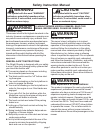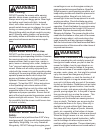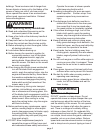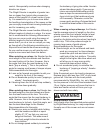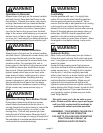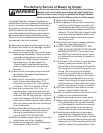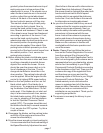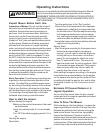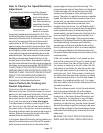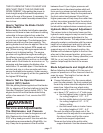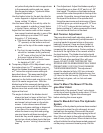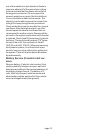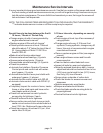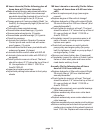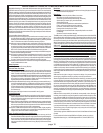
page 9
WARNING
brake should now be applied. Now check if the
parking brake interlock prevents you from mov-
ing both of the hand control levers from the
neutral position. (If not, service the parking brake
interlock.) While standing on the foot platform,
increase the engine speed to about half of the
way from idle speed. Release the parking brake.
The higher engine speed will make the controls
much more responsive and the mower a lot
quicker, so be careful if it is your first time. Now
try moving the hand control levers, one at a time,
very slightly, forward and backward. Gradually
increase your speed until you are very ac-
quainted with the operation of the hand controls
and the mower's behavior. After gaining a good
feel for how the mower handles gradually attempt
higher engine speeds until familiar with opera-
tion at full throttle engine speed.
How To Stop and Park The Mower
Come to a complete stop. If the blades are on,
turn them off using the switch on the instrument
panel. Make sure the control levers are in the
exact neutral position. Set the parking brake,
reduce the engine speed to idle, shut off the
ignition switch to stop the engine and remove the
key from the ignition switch. The mower is now
parked. Do not leave parked unattended on a
sloped surface.
How To Drive The Mower Over a
Curb
To climb a curb, first see the Safety Instruction
Manual section of this manual, especially the
parts on:
•
Initial Operating Safety Guidelines
•
Operation In Reverse
•
Operation In Forward Direction
Next, drive the mower in reverse, at a 45 de-
gree angle to the curb, with the left side of the
mower closest to the curb until you are within
an inch or two of the left-rear tire hitting the
curb. Stop and then gradually bump into the curb
with that tire until it is just on top of the curb. If the
tire slips even while lurching the mower into the
curb then the curb is too high and you should use
ramps or find another way. The mower should
still be at 45 degree angle to the curb. Now,
while maintaining the same angle to the curb,
continue to back up until the right-rear tire is
close to the curb. Using the same technique lurch
the right tire on to the curb. After both wheels are
on top of the curb, turn the mower counterclock-
wise and back up so the left caster wheel comes
over and last should be the right caster wheel as
the mower is twisting to the left (counterclock-
wise). The technique works the best if you try not
to drive backwards at a near 90 degree angle to
the curb but get all of the wheels to go over while
the mower is moving at least a 45 degree angle to
the curb. To drive off a curb first, try driving up
onto it to make sure the curb is not too high. If the
curb is not too high, drive the right-front caster off
first while driving toward the curb at a 45 degree
angle (the curb should be to your right). Then,
maintaining that 45 degree angle so the left caster
goes over, then the right-rear wheel, then the left
rear wheel.
Never drive straight on to or off of a curb.
Never drive straight on to or off of a curb. If you
do the whole procedure at a very sharp angle it
will tend to minimize the contact of the mower
deck with the curb and you will be able to more
safely control the mower.
How To Use The Mower On Varying
Terrain
See the Safety Instruction Manual section of this
manual, especially the parts on:
•
Initial Operating Safety Guidelines
•
Operation On Slopes
•
Operation In Reverse
•
Operation In Forward Direction
•
Operation During Zero-Radius Turns



